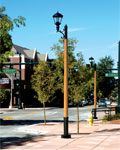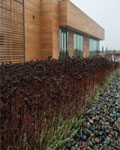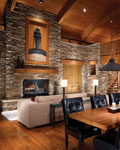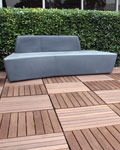Building Green
Using Manufactured Stone Veneers to Mitigate Environmental Impacts
Natural stone is a durable, attractive product that must be quarried and processed to make it usable as a veneer or architectural siding. Manufactured architectural stone veneers are also durable, attractive, and manufactured for use as both interior and exterior veneers and siding. They are one-third the weight and one-half the installation cost of natural stone. They are also sustainable and place minimal impact on the natural environment because they are not quarried but are cast from molds.
The manufacturing process involves having the fabricators visit quarries to select pieces of natural stone that have already been quarried. Molds are then cast from these natural stone pieces. The molds are filled with Portland cement, lightweight aggregate, and iron oxide dyes so that the veneer pieces are fabricated in the appropriate size and color. The natural stone textures are achieved because the molds are created from natural quarried stone pieces. Some manufactured stone veneer products come with an extended warranty. Manufactured stone veneers are easily maintained and damaged pieces can be replaced by re-casting the molds.
Manufactured stone veneers are fabricated in large multi-panel systems, which facilitate installations covering extremely large areas and allow a much larger surface area to be covered in less time than in a natural stone application. The variation of natural stone is achieved by replicating limited areas of natural stone mold per profile so that there is less chance of repetition.
|
As manufactured stone veneers are not quarried, there is only a 2 percent waste in their fabrication versus a 10 percent waste with natural stone. The lighter weight of the veneer reduces both the energy use and cost involved with shipping and all of the manufactured stone veneers can be recycled and reused. Additionally, their light weight eliminates the need for wall ties, and thus they are designed to adhere easily to a variety of structurally sound surfaces, and are capable of being used in installations that would normally be very difficult and costly to achieve with natural stone.
Manufactured stone veneers are tested for freeze/thaw durability. As with any installation, installers should incorporate good building practices which include proper flashing and water diversion techniques to help ensure a successful installation. The base color in manufactured stone veneers is blended throughout and permanent mineral oxide pigments are applied and absorbed when the veneer is cast. The color is an integral part of the veneer and there are minimal noticeable color changes after years of weathering.
 |
An example of a manufactured stone veneer pattern that mimics natural stone Photo courtesy of Eldorado Stone |
Manufactured stone veneer is easy to maintain by simply cleaning dirt or other particles with a soft bristle brush. If necessary a mild type of detergent mixed with water can be used to clean the surface of the stone. Rinse right away with clean water to remove any cleaning solution that might remain on the surface. Never use wire brushes, acid cleaners, power washers, bleach, paint remover, or any other type of concrete cleaner. If efflorescence occurs, it may be removed with a solution of 1 part mild detergent to 6 parts water. Scrub using a soft bristle brush. Rinse well with clean water. It is not necessary to seal manufactured stone veneers but if a sealant is applied, it will provide added protection and make it easier to clean. There are urethane and wax-based sealers that can damage the surface or cause it to “yellow.” Other sealers may encourage additional efflorescence on the stone's surface.
The manufactured stone veneer is essentially a concrete product meeting the following composition and standards:
• Cement meeting the requirements of ASTM C150, C595, or C989
• Pozzolans meeting the requirements of ASTM C618
• Aggregates meeting the requirements of ASTM C33, C330, or C331
• Admixtures
• Coloring pigments
• Potable water
Manufactured stone veneers have been used both on the exterior and interior of buildings for walls, chimneys, and accents on residential, commercial, and municipal projects. These products come with long-term warranties. However, manufactured stone veneers cannot be used in pools, fountains, showers or water features nor can they be used as a horizontal surface such as patios or floors. Some examples of projects using manufactured stone veneers include a cabin near Lake Superior in northwestern Wisconsin, designed by architect Tom Jones of TRJ Design in Trabuco Canyon, California. Mr. Jones stated:
“I wanted to create a home where they could live year round if they chose with a clean, open floor plan and a simple design that always keeps nature at the forefront. My parents are fans of modern architecture, but not the sterile style. To add warmth and natural beauty to the plans, we used three key design elements—wood, glass, and manufactured stone veneer.”
Manufactured stone veneer was also used to complement other organic building materials at Parkland Golf and Country Club in Florida. Throughout the community, stone, wood, water, and other organic materials were used as the primary elements to define the context of the landscape and residences. Manufactured stone veneer is used on both the exterior and interior of the sports club, on bridges, community signage, and on various homes throughout this community.
“The level of detail and thoughtfulness found in every aspect of this community is highly unique and very special,” says Margaret LaCalle, project manager for WCI Communities, the developers of the Parkland golf community. “The feeling here is magical and I believe the architectural beauty and the ambience created with the use of the manufactured stone veneer helps to capture the true essence of Parkland Golf and Country Club.”
Conclusion
As we look to reduce our carbon footprint and move towards more net-zero projects, demand will increase for the construction of buildings that minimize impacts to the environment and provide opportunities for energy savings both in their construction and maintenance. There will also be a continued demand for products which are either harvested from renewable resources or fabricated using materials that are not toxic and which do not drain non-renewable natural resources.
| ENDNOTES | |
| 1 | www.forestlearning.edu.au |
| 2 | U.S. Department of Agriculture Forest Service, Forest Product Laboratory: Research Paper FPL-Rp-565, Mechanical Properties of Salvaged Dead Yellow Cedar in Alaska: Phase 1, K. McDonald, P. Hennon, J. Stevens, D. Green. |
| 3 | A typical FM Approvals program for roofing includes fire testing above and below the deck, wind-uplift testing, hail-damageability testing, accelerated weathering testing, and corrosion resistance testing of ferrous metal parts. |
| 4 | http://living-future.org/lbc |
| 5 | Refer to https://www.seattle.gov/DPD/cityplanning/completeprojectslist/greenfactor/ for more detailed information. Portland, Oregon also uses an incentive calculation that evaluates the return on investment in green design components. |
 |
 |
 |
 |
Notice

www.cavawood.com

www.columbia-green.com

www.eldoradostone.com

www.tournesolsiteworks.com/boulevard.html









